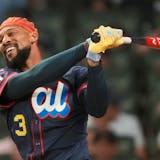When the world changed in March and most fish and wildlife workers retreated to work from home, licensing center employees at the Department of Natural Resources reported to the office to keep issuing permits of all kinds.
They kept open the machinery that fed the story of the year in Minnesota's outdoors: an unprecedented embrace of fishing, hunting, camping, hiking, biking, boating and trail riding. To escape the constraints of the global coronavirus pandemic, people flocked to the state's lakes, rivers, woods, parks, trails, campgrounds and wilderness areas.
"It's so great that people are choosing to spend more time in the outdoors," DNR Fish and Wildlife Chief Dave Olfelt said. "We have an outdoors-oriented culture in Minnesota, and that circle must get bigger. We need everyone to be connected to it."
Lifted by the appeal of built-in social distancing amid nature, the DNR sold 100,000 more fishing licenses than it did in 2019 and issued twice as many state forest camping permits. The declining sport of duck hunting experienced a rebound that no one could have foreseen while all-terrain vehicle ridership surged to new levels. In the Boundary Waters Canoe Area, so many newcomers paddled their way into the wild that the U.S. Forest Service was forced to close an unusually high number of campsites where bears became accustomed to finding food.
In a normal year, 10 million people visit Minnesota's 75 state parks and recreation areas, including 1.1 million campers. In 2020, through November, visitation had soared by 51% at parks near the metro area. Statewide, the attendance blast was 23% above the level in 2019. Also through November, state trail use exploded by about 50%, according to the DNR.
State Parks and Trails Director Erika Rivers said the resources were magnets for people who "sought safe ways to get some exercise and the calming experiences of nature-based recreation."
The uplifting trend of greater participation in everything from bird-watching to spring turkey hunting arrived in the face of COVID-19 setbacks. Minnesota's anglers and waterfowl hunters were blocked from entering Canada, fishing resorts in the Northwest Angle were nearly deserted by the closure, fundraising tanked for wildlife conservation groups like Pheasants Forever from the cancellation of banquets, DNR gave up on walleye stocking and other field work, overnight camping was initially shut down in state parks and conventions like the Minneapolis Boat Show and the Game Fair in Ramsey were ditched.
More recently, the deadly disease outbreak changed the way Minnesota deer hunters gathered for the annual harvest. Many who normally convened with family and friends in tradition-laden camps retrenched from their far-flung deer shacks to abide by social distancing requirements.
![A black bear stopped after crossing Big Bay Road on Madeline Island, the largest of the Apostle Islands in Wisconsin, on Monday, May 31, 2021. ]](https://arc.stimg.co/startribunemedia/PWNYGIY3WTSWDBOGOYD775DPP4.jpg?&w=80&ar=1:1&fit=crop)

